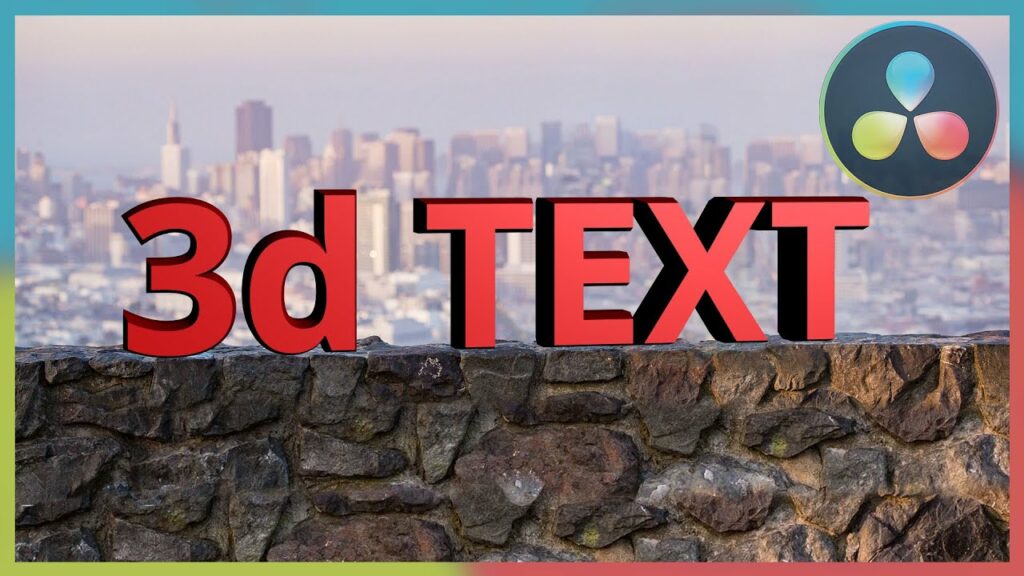Mastering the Art of 3D Text Creation in DaVinci Resolve: A Comprehensive Guide

Introduction: In the realm of visual storytelling, text serves as a powerful tool for conveying information, setting the mood, and guiding viewers through narratives. With the advent of 3D technology, text has transcended its two-dimensional constraints, evolving into dynamic, immersive elements that captivate audiences and enhance visual impact. In this comprehensive guide, we delve into the intricacies of creating 3D text in DaVinci Resolve, unlocking a world of creative possibilities for filmmakers, content creators, and motion graphics enthusiasts.
Section 1: Understanding 3D Text in DaVinci Resolve Before diving into the process of creating 3D text, it’s essential to understand the fundamentals of 3D typography and its integration within the DaVinci Resolve environment. This section provides an overview of the key concepts and terminology associated with 3D text, including extrusion, beveling, and material properties.
- Exploring text attributes: DaVinci Resolve offers a myriad of customization options for text elements, allowing users to manipulate attributes such as font style, size, alignment, and spacing. Familiarize yourself with these attributes to tailor your 3D text to suit the aesthetic and thematic requirements of your project.
- Understanding extrusion and beveling: Extrusion and beveling are fundamental techniques in 3D text creation, enabling users to add depth and dimensionality to their typography. Learn how to extrude text along the z-axis to create volumetric shapes, and apply beveling to edges for added realism and visual appeal.
Section 2: Creating 3D Text Objects With a solid grasp of 3D text fundamentals, it’s time to embark on the process of creating dynamic text objects within DaVinci Resolve. This section explores various techniques for generating and customizing 3D text elements, from simple title cards to intricate motion graphics.
- Adding text layers: DaVinci Resolve’s Fusion page serves as the hub for 3D text creation, offering a robust array of tools and functionalities for text manipulation. Learn how to add text layers to your composition, adjust text attributes, and position text elements within the 3D workspace.
- Extruding and beveling text: Elevate your 3D text creations by applying extrusion and beveling effects to add depth and dimensionality. Experiment with different extrusion depths, bevel profiles, and materials to achieve the desired visual impact and stylistic flair.
Section 3: Customizing Text Materials and Effects Texture and material properties play a pivotal role in defining the appearance and realism of 3D text objects. This section delves into techniques for customizing text materials, applying textures, and incorporating visual effects to enhance the visual appeal of your 3D typography.
- Applying materials and textures: DaVinci Resolve offers a wide range of material presets and texture options to imbue your 3D text with richness and depth. Experiment with different material properties such as reflectivity, roughness, and transparency to achieve realistic surface effects and visual textures.
- Incorporating visual effects: Elevate your 3D text creations with dynamic visual effects that enhance realism and visual impact. Explore techniques for adding shadows, reflections, and lighting effects to simulate natural lighting conditions and create immersive, cinematic compositions.
Section 4: Animating 3D Text Objects Animation breathes life into static 3D text, transforming it into dynamic elements that captivate and engage viewers. This section explores techniques for animating 3D text objects, including keyframe animation, procedural animation, and dynamic simulations.
- Keyframe animation: Utilize keyframe animation techniques to animate 3D text objects along defined paths, manipulate properties such as position, rotation, and scale, and choreograph complex motion sequences with precision and control.
- Procedural animation: Explore the versatility of procedural animation techniques, such as dynamics and constraints, to imbue your 3D text with dynamic, lifelike behavior. From simulating physical interactions to creating text animations that respond to external forces, procedural animation opens a world of creative possibilities within DaVinci Resolve.
Section 5: Integrating 3D Text into Video Projects The true power of 3D text in DaVinci Resolve lies in its seamless integration with traditional video editing workflows. This section explores techniques for incorporating 3D text elements into video projects, blending virtual and real-world footage to create immersive visual experiences.
- Compositing 3D text: Leverage DaVinci Resolve’s Fusion page to composite 3D text seamlessly into your video projects. Explore techniques for integrating text layers with live-action footage, adjusting lighting and shading to achieve seamless realism, and applying visual effects to enhance immersion and impact.
- Tracking and matchmoving: Achieve seamless integration of 3D text with live-action footage through precise tracking and matchmoving techniques. Utilize DaVinci Resolve’s tracking tools to align text elements with the movement and perspective of your video footage, ensuring seamless integration and visual coherence.
Section 6: Rendering and Exporting 3D Text Animations With your 3D text animations meticulously crafted and integrated into your video projects, the final step is rendering and exporting your creations from DaVinci Resolve. This section guides you through the rendering process, offering tips and best practices for optimizing render settings, managing output formats, and ensuring optimal visual fidelity and compatibility across platforms.
- Render settings optimization: Fine-tune render settings to achieve the perfect balance between visual quality and rendering speed. Explore options such as resolution, frame rate, compression settings, and render passes to tailor your output to the specific requirements of your project.
- Output formats and presets: DaVinci Resolve offers a wide range of output formats and presets to accommodate diverse delivery platforms and distribution channels. Whether targeting high-definition displays, streaming platforms, or social media, leverage DaVinci Resolve’s flexible output options to ensure your 3D text animations reach their audience in stunning clarity and detail.
Conclusion: The creation of 3D text in DaVinci Resolve represents a gateway to boundless creativity and innovation, empowering users to craft dynamic, immersive visual experiences that captivate and inspire audiences. By mastering the tools and techniques outlined in this guide, you unlock the full potential of 3D typography, transforming your creative vision into reality with unparalleled depth, dimensionality, and impact. Embrace the journey of exploration and discovery, and let DaVinci Resolve be your canvas for limitless expression and artistic excellence in the realm of 3D text creation.







